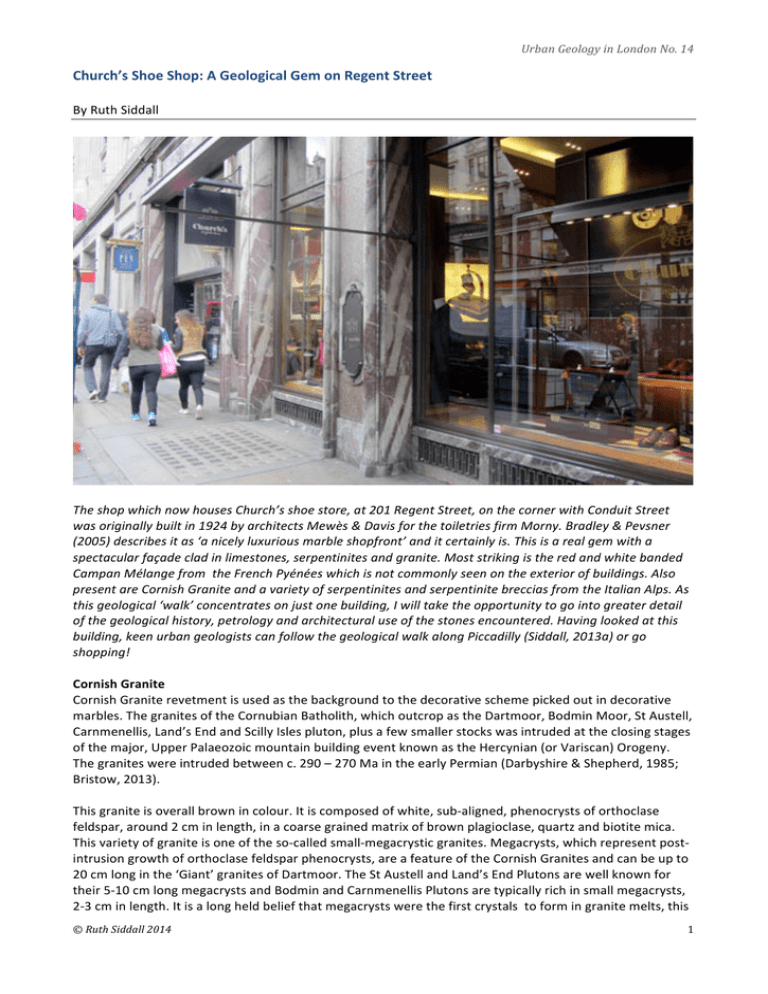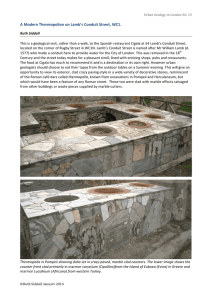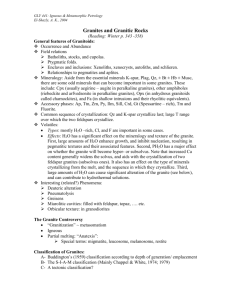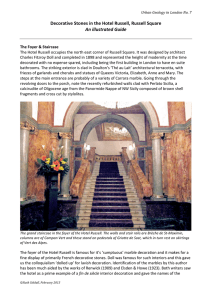Document 12425222
advertisement

Urban Geology in London No. 14 Church’s Shoe Shop: A Geological Gem on Regent Street By Ruth Siddall The shop which now houses Church’s shoe store, at 201 Regent Street, on the corner with Conduit Street was originally built in 1924 by architects Mewès & Davis for the toiletries firm Morny. Bradley & Pevsner (2005) describes it as ‘a nicely luxurious marble shopfront’ and it certainly is. This is a real gem with a spectacular façade clad in limestones, serpentinites and granite. Most striking is the red and white banded Campan Mélange from the French Pyénées which is not commonly seen on the exterior of buildings. Also present are Cornish Granite and a variety of serpentinites and serpentinite breccias from the Italian Alps. As this geological ‘walk’ concentrates on just one building, I will take the opportunity to go into greater detail of the geological history, petrology and architectural use of the stones encountered. Having looked at this building, keen urban geologists can follow the geological walk along Piccadilly (Siddall, 2013a) or go shopping! Cornish Granite Cornish Granite revetment is used as the background to the decorative scheme picked out in decorative marbles. The granites of the Cornubian Batholith, which outcrop as the Dartmoor, Bodmin Moor, St Austell, Carnmenellis, Land’s End and Scilly Isles pluton, plus a few smaller stocks was intruded at the closing stages of the major, Upper Palaeozoic mountain building event known as the Hercynian (or Variscan) Orogeny. The granites were intruded between c. 290 – 270 Ma in the early Permian (Darbyshire & Shepherd, 1985; Bristow, 2013). This granite is overall brown in colour. It is composed of white, sub-­‐aligned, phenocrysts of orthoclase feldspar, around 2 cm in length, in a coarse grained matrix of brown plagioclase, quartz and biotite mica. This variety of granite is one of the so-­‐called small-­‐megacrystic granites. Megacrysts, which represent post-­‐ intrusion growth of orthoclase feldspar phenocrysts, are a feature of the Cornish Granites and can be up to 20 cm long in the ‘Giant’ granites of Dartmoor. The St Austell and Land’s End Plutons are well known for their 5-­‐10 cm long megacrysts and Bodmin and Carnmenellis Plutons are typically rich in small megacrysts, 2-­‐3 cm in length. It is a long held belief that megacrysts were the first crystals to form in granite melts, this © Ruth Siddall 2014 1 Urban Geology in London No. 14 assumption was made based on well-­‐developed crystal faces associated with these crystals thought to have developed in a melt environment, where crystal growth was unrestricted. Any alignment was similarly interpreted to be magmatic and the result of melt flow. This has always presented a conundrum for field geologists and petrologist as such large crystals are not encountered in eruptive silicic rocks be they in the form of pyroclastic material or as lavas, and paradoxically, potassic feldspar (orthoclase) is typically one of the last minerals to crystallise in melts. Recent work, such as the case argued by Glazner & Johnson (2013) has shown that megacrysts form late in the cooling history of the granites when the melt is frozen and these phases therefore crystallise in the solid-­‐state (like minerals in metamorphic rocks) late in the cooling history of the granites; the process is probably aided by hot fluids flowing through the rock. Such criteria are valid for the Cornubian granites which were particularly fluid-­‐rich as shown by the extensive mineralisation forming tin and kaolinite (china clay) deposits. Any foliation observed is more likely to be driven by tectonic processes, i.e. movement on adjacent faults, rather than magmatic ones and this setting is supported by the Cornish plutons described below, where faults lie alongside the plutonic masses. The variety of ‘small’ megacrystic granite as observed here on Regent Street is known from Trolvis Quarries at Penryn, near Falmouth, but very similar varieties are known from other quarries in the Carnmenellis and Bodmin Plutons. Therefore, the precise origins of this granite cannot be determined. A variety of granites were produced from the Carnmenellis Pluton, particularly from the SW of the intrusion in the parishes of Mabe and Constantine. The granite was shipped from wharves on the River Fal and 40 quarries were in operation around Mabe in the 1840s, predominantly owned by the Freeman family, who also owed a cutting and polishing works at Penryn. The Carnmenellis Pluton has an inner, coarse grained megacrystic granite, but this was only quarried for the porphyritic dyke rocks locally called elvans. The centre of the intrusion is also cut by ENE-­‐orientated fissures which would have reduced the quality of dimension stone. The outer, biotite-­‐rich zone of the intrusion contains ‘small’ megacrysts which are variably foliated (Bristow, 2013). Production of stone has continued through the 19th and 20th Centuries and there are several quarries being worked today for aggregate. Dimension stone is no longer quarried on the Carnmenellis Pluton. De Lank Quarry is Cornwall’s only operating quarry still producing dimension stone. It is situated on the NW edge of the Bodmin Pluto, near St Breward. The quarry takes its name from the De Lank River and its main axis is cut into the valley of this river. The Quarry was opened in 1834 after the construction of the Bodmin & Wadebridge Railway which allowed transportation to the shipping quays on the Camel Estuary. Browner-­‐ coloured, small-­‐megacrystic granites come from Hantergantick Quarry, just a few hundred metres from the main De Lank Quarry. Hantergantick operated from 1918, closing in 1997. Left: The Carnmenellis Granite and the location of quarries (after Bristow, 2013); Right; Brown, small-­‐megacrystic granite, shown at actual size. © Ruth Siddall 2014 2 Urban Geology in London No. 14 If I were a betting woman, based on comparison of this stone with samples in the Natural History Museum’s building stone collections, I would put money on this granite on Church’s shoe shop as coming from the Penryn area of the Carnmenellis Granite. The Campan Marbles A range of Devonian ‘amygdaloidal’ limestones are quarried in the French Pyrenées and used as decorative marbles. Although they have undergone low-­‐grade metamorphism these rocks are not ‘true’ marbles in the geological sense. In the building stone industry, the term marble is used to describe any hard limestone which can take a high polish and these stones fit that definition. ‘Amygdaloidal’ means ‘almond-­‐like’ and this is because the characteristic feature of these limestones is that they are nodular, with the nodules the size and shape of almonds. They are sometimes ivory in colour completing the resemblance. More properly this series of strata are known as the Griotte Limestones. The food metaphors continue, ‘griotte’ is the French word for Morello cherry and in may of the outcrops, the limestones are dark cherry red. The word Griotte has become used in geological parlance to refer to often red, nodular limestones, representing a condensed, relatively deep marine sequence. Griottes sensu lato have been widely exploited as decorative stones and prominent uses include the Devonian Griotte Limestones of the Pyrénées and associated lithologies in the French Massif Central (Griotte d’Italie or Partridge-­‐Eye Marble) and the Jurassic ammonitico rosso facies which has been worked in various localities in Spain, around Verona, Italy and in Austria (Adnet Marble), Hungary and Greece. The Pyrénéan mountain chain has a complex geological history, having been assembled during two major mountain building episodes, the Upper Palaeozoic Hercynian (Variscan) and Cretaceous-­‐Tertiary Alpine Orogenies (Mirouse, 2008; Jolivet et al., 2007). The Griotte Limestones were deposited in the northern foreland basin of what would become the Pyrénées and form part of a continuous stratigraphy with sediments ranging in age from Silurian to Carboniferous (Souquet et al., 2003; Garcia-­‐Sansegundo, 1996). The Devonian strata are varied and include sandstones, shales and limestones. The Griotte Limestones, of Upper Devonian Frasnian-­‐Fammenian age (Sanz-­‐Lopez, 2002) were clay-­‐rich, carbonate mudstones, deposited in an open marine, relatively deep water environment, probably transitional between the continental shelf and ocean basin (Souquet et al., 2003). They are well-­‐bedded, nodular, and rich in fossil debris, particularly cephalopods (goniatites), brachiopods (tentaculites) and conodont and ostracod microfossils. For the most part they are red or pink in colour, this is due to concentrations of the iron oxide hematite induced by ferrobacteria (Mamet & Perret, 1995). Green, white and colour banded varieties also occur. These strata were considerably deformed during Hercynian collision under a compressional, thin skinned thrust tectonic regime, which produced a series of tight, north-­‐verging fold structures, subjected to greenschist facies metamorphism (Pouget, 1991; Garcia-­‐Sansegundo, 1996). In the case of the Campan Marbles an additional thermal metamorphic overprint was imparted by the intrusion of the Néouvielle Granite at 300 Ma (Alibert et al., 1988; Gleizes et al., 2001). This metamorphism has hardened the limestones, improving their ability to be slabbed and polished, and converted the clay minerals present to micas, including the green mica chlorite, and epidote, which are responsible for the colour of the green varieties of marble worked. The rocks are also cross-­‐cut with conjugate sets of fractures, infilled with white calcite which are associated with the phases of folding. Alpine tectonics emplaced these Palaeozoic sedimentary basins southwards, piggy-­‐back style, on major, thick-­‐skinned nappes and they are now exposed in the Soulan and Salat tectonic units of the northern Pyrénées, separated by the Bosost Dome (Souquet et al., 2003; Pouget, 1991) and in the Aran Syncline on the French-­‐Spanish border (Garcia-­‐ Sansegundo, 1997). The main quarrying locations of the Griotte Limestones are at Espiadet where red, pink, green and banded varieties of Campan Marbles are extracted and at Sost, NW of Bagnères-­‐de-­‐Luchon where red ‘classic’ griottes are quarried, known as Griotte de Sost. Both of these deposits are located in the Soulan Unit. In the eastern Salat Unit, a green and white variety called Vert d’Estours or Vert d’Eau is quarried in the Estours Valley, south of Seix. © Ruth Siddall 2014 3 Urban Geology in London No. 14 A cross-­‐section through the Pyrénées in the region of Neouvielle and Espiadet, showing the structural relationships of the Devonian and Carboniferous sediments (at far right) with the Neouvielle Granite and major Cretaceous-­‐Tertiary structures such as the Gavarnie Thrust (after Jolivet et al., 2007). A tectonic map of the Central Pyrénées with the locations of the major Griotte Limestone quarries (after Souquet et al., 2003). The Campan Marbles are quarried at Espiadet, near the village of Payolle, The quarries, which have been active since the Roman period and are still active today, are situated at the head of the Campan Valley, a few kilometres east of the Col de Tourmalet and the Pic du Midi de Bigorre (2,877 m). Watson (1916) describes the region as ‘bordered on one side by green, undulating hills, and on the other by precipitous crags among which are the numerous quarries.’ The stone extracted is known as Campan Marble. Geologically Espiadet lies a few kilometres north of the Néouvielle Granite, a Late Carboniferous syn-­‐ tectonic granite intruding the Devonian and Carboniferous sediments of the Soulan Unit. Although worked since the Roman period, the Campan Marbles gained great popularity in the 17th Century in France when the quarries, closed since the Middle ages, were reopened and the stone was used in the interior decoration of the Palace of Versailles. Campan Marble went on to be used monumentally and for fittings, especially fire surrounds throughout the 18th and 19th Centuries (Price, 2007). The quarries were not continually in action during these times and remained closed for the majority of the 19th Century, reopening in the 1880s. Campan Marbles became popular in British architecture in the late 19th Century (see Renwick, 1909; Watson, 1916). Several varieties of stone were quarried at Espiadet, all cross-­‐cut by white calcite veins. A green variety is known as Campan Vert or Cipollino Mandolato. Mandolato is italian © Ruth Siddall 2014 4 Urban Geology in London No. 14 for the sweet nougat and is another reference almond-­‐like shape of the nodules. ‘Cipollino’ is also a food derived term and means little onion in Italian. It was fashionable to give stones Italian names and the original Cipollino was actually quarried in Greece and is a white and green banded marble, thought by some to convey the effects of slices through an onion. The colour varies from pale to dark green and Campan Vert has always been one of the most popular of the Campan marbles. According to Watson (1916) it was widely used in the early 20th Century for the table tops of Parisian cafés. Pink varieties were known as Campan Rosé, Campan Rosé et Vert and Campan Isabelle (with rusty red colouration; Watson, 1916). Campan Rouge was a classic brownish-­‐red griotte and Campan Mélange or Campan Rubané (Ribbon Campan), was, as the name suggests, striped with chocolate-­‐brown red and green bands. Examples of many varieties of Campan marbles can be seen today in Westminster Cathedral in Victoria (Rogers, 2008), in the Hotel Russell, Russell Square (Renwick, 1909; Siddall, 2013b) and in the old University College Hospital building, now the UCL Cruciform Building on Gower Street (Siddall et al., 2013). The variety Campan Mélange is used to great effect on Church’s shoe shop on Regent Street. A sample of Campan Mélange from UCL Earth Sciences Building Stone Collection (cat. P6841) showing ‘amygdaloidal’ nodular texture and bands of pink and red limestone. Wisps of green chlorite can be seen surrounding the nodules as well as cross-­‐cutting calcite veins. Rosso Levanto and Alpine Serpentinites Serpentinites feature on Church’s shop front at foundation level at the corner of Regent Street with Conduit Street and framing the medallions with the shop name. They also form the grounds of the medallions on the entrance at 70, Conduit Street. Wine red, green and red and dark green varieties occur. This mix and the variable degree of weathering observed on this soft stone suggests that not all of these serpentinites are original features. Serpentinite is a rock which s predominantly composed of the serpentine group clay minerals. Other minerals, generally in a finely disseminated form, occur in serpentinites, predominantly talc, a variety of amphibole called tremolite and iron oxides. Serpentinites can be subdivided into two main types; tremolite serpentinites are homogeneously fine grained and often streaked and veined. Bastite serpentinites have bronzy crystals, usually about 3-­‐5 mm in length, which are larger than the otherwise very fine grained groundmass, these are the ‘bastites’ which are replacements of orthopyroxene by an intimate mixture of talc and tremolite. This is such a faithful replacement of the pyroxenes, a ‘pseudomorph’, so that relic features like cleavage are retained and often visible with a hand © Ruth Siddall 2014 5 Urban Geology in London No. 14 lens. Serpentinites form when rocks formed in the Earth’s lower crust and mantle are uplifted and emplaced in the upper crust by a plate tectonic process called obduction to form rock masses called ophiolite complexes. Mantle rocks, peridotites and pyroxenites, are composed of olivine, pyroxene and spinel group minerals, primarily magnetite. They do not contain minerals associated with the upper crust such as quartz and the feldspars. These rocks form and are stable at high temperatures and pressures. When they are subjected to the low pressure, low temperature and wet environment of the upper crust, they undergo metamorphism to form serpentinites and considerably expand in volume. This expansion, plus the fact that they are tectonically emplaced almost always results in brecciation so that serpentinites are riddled with fractures. Serpentinites are variably cross-­‐cut by calcite veins, often distinctively white. The profusion of calcite is a result of the marine environment coupled with excess calcium produced by the breakdown of clinopyroxenes. Most of the serpentinites on Church’s (left) are red and these are not particularly common – most serpentinites quarried are shades of green. The red colour is imparted by the iron oxide mineral hematite which forms from the oxidation of magnetite. Red serpentinites are known from the Lizard in Cornwall, but wine-­‐red serpentinites are traditionally quarried from ophiolites forming the Levanto Massif of Liguria, Italy, around 60 km south along the coast from Genoa and they are known architecturally as Rosso di Levanto. This is part of a chain of ophiolites lying in an arc through the southern Alps in the Piedmont and Liguria regions of Italy. Green serpentinites are quarried in the Val D’Aosta and are generically known as Verde Alpi and also around Genoa, where they are called Verde di Genova. Rosso di Levanto has been quarried from several quarries around the village of Bonassola, with those of San Giorgio and Rossola still active (Perrier, 1996). These quarries have been worked since at least the 12th Century. It was widely used in Italian ecclesiastical architecture and like many decorative marbles gained popularity in England and France in the later 19th Century. It was used in Westminster Cathedral in 1903 (Rogers, 2008) although Watson (1916) says that at the time of his writing its use was going into decline. Rosso di Levanto is a bastite serpentinite, showing variable amounts of brecciation from massive, almost coherent blocks to highly fragmented, matrix supported breccias. Perrier (1996) visited the quarries and found that there was variation between purplish-­‐red serpentinite and a green variety (called Verde Levanto; Watson, 1916). He found that the red colour penetrated lenses of serpentinite so that some were red on the outside with green cores. The masses is liberally streaked with white calcite veins. Treves & Harper (1994) and Marroni & Pandolfi (2007) have studied the stratigraphy of the Levanto Massif (see section, right) and have shown that the massive Levanto serpentinite becomes progressively more brecciated upwards, with a highly brecciated layer, with centimetric to © Ruth Siddall 2014 6 Urban Geology in London No. 14 decimetric-­‐scale clasts of red and greenish bastite serpentinite supported in a very fine grained calcite matrix, which is suffused with red, again the result of hematite. This layer is called the Framura Breccia and it marks the uppermost section of the ophiolite exposed here. It is overlain by Jurassic radiolarian cherts and pillow basalts and then by Lower Cretaceous turbidites (Treves & Harper, 1994). Both the massive serpentinite and the Framura Breccia were used architecturally, although both varieties were marketed under the same name as ‘Rosso di Levanto’. At Church’s, Framura Breccia is used on the skirtings (which have been damaged) on the corner of Conduit Street. UCL Earth Sciences Building Stone Collection has a sample of ‘true’ Rosso di Levanto (P6850) supplied by marble contractors J. Whitehead & Sons Ltd. of Kennington Oval (below, left) and a sample of the Framura Breccia (P6828) from rival firm Fenning & Co. Ltd. of Hammersmith (below, right). Both samples shown below are of identical size, 8.5 cm wide. A serpentinite, almost identical in appearance to Rosso di Levanto is quarried today near Elazig in central-­‐ east Anatolia and is marketed as Rosso di Levanto Turchia. The green serpentinites used on the medallions on the Conduit Street elevation of Church’s are probably examples of Verde Alpi from the Val D’Aosta or Genoa, which were by far the largest producers of decorative serpentinites until relatively recently. Verde Alpi is a generic name for serpentinites quarried in the three ‘basins’ of the Val D’Aosta and generally includes serpentinites from other ophiolite bodies around the Piemontese Zone. There are ~ 20 quarries in the Val D’Aosta area, but less than half of these are currently in production (Sandrone et al., 2004). The serpentinites worked are very heterogeneous in terms of colours and textures. Both bastite and tremolite serpentinites occur. Similar and geologically related stones are also quarried at Pietralavezerra near Genoa (Verde Genova) and at Maurin (Vert Maurin) in the French Alps. All these stones were widely and indiscriminately used and described at Verde Alpi or Vert des Alpes in the late 19th and early 20th Century (Renwick, 1909). The variety used on the medallions on Conduit Street resembles Verde Genova and compares well with sample P6862 in UCL Earth Sciences Building Stone Collection. However it may equally be Vert Maurin or a Verde Alpi from the Aosta Valley. The façade created for the luxury toiletries firm Morny Frères was a fitting tribute to the companies acquired airs and graces. Morny was in fact owned by Englishman Sidney F. Goss who named it after a racehorse called Mornington, and though it gave the impression of being aristocratic and Parisian (and even opened shops in Paris), it was not. Nevertheless the prominent use of French stone, at their height of opularity in Paris during the preceding few decades, may have been intentional, encouraging this illusion. Morny is still going strong today, and more about the history of the firm can be found on their website © Ruth Siddall 2014 7 Urban Geology in London No. 14 (listed below). Church’s English Shoes is aptly named after 18th Century Northamptonshire cobbler Mr. Stone Church. The current business was founded by his great grandson in 1873 and they opened their first London shop in 1921. Church’s are nowadays an international luxury brand, they still hand-­‐make their men’s shoes at their factory in Northampton. Many of their shops feature luxury stones as well as luxury shoes and we will visit other branches of Church’s in future walks. References Alibert, C., Debon, F. & Ternet, Y., 1988, Le pluton à structure concentrique du Néouvielle (Hautes Pyrénées): typologie chimique, âge et genèse. C. R. Acad. Sci. Paris., 306, 49-­‐54. Bradley, S. & Pevsner, N., 2005, The Buildings of England: London 6; Westminster., Yale University Press., p. 456. Bristow, C. M., 2013, The geology of the building and decorative stones of Cornwall, UK., in: Cassar, J., Winter, M. G., Marker, B. R., Walton, N. R. G., Entwisle, D. C., Bromhead, E. N. & Smith, J. W. N. (eds) Stone in Historic Buildings: Characterization and Performance. Geological Society, London, Special Publications, 391. Church’s English Shoes: http://www.church-­‐footwear.com/en/UK/new-­‐collection#!/en/UK/history Darbyshire, D. P. F. & Shepherd, T. J., 1985, Chronology of granite magmatism and associated mineralization, SW England., Journal of the Geological Society, 142, 1159-­‐1177. Garcia-­‐Sansegundo, J., 1996, Hercynian Structure of the Axial Zone of the Pyrenees through the Aran Valley cross-­‐ section (Spain -­‐ France)., Journal of Structural Geology, 18 (11), 1315-­‐1325. Glazner, A. F. & Johnson, B. R., 2013, Late crystallization of K-­‐feldspar and the paradox of megacrystic granites., Contributions to Mineralogy and Petrology., 166, 777-­‐799. Gleizes, G., Leblanc, D., Olivier, P. & Bouchez, J. L., 2001, Strain partitioning in a pluton during emplacement in transpressional regime: the example of the Néouvielle granite (Pyrenees)., International Journal of Earth Sciences., 90, 325-­‐340. Howe, J. A., 1910, The Geology of Building Stones., Edward Arnold, London., 455 pp. Jolivet, M., Labaume, P., Monié, P., Brunel, M., Arnaud, N. & Campani, M., 2007, Thermochronology constraints for the propagation sequence of the south Pyrenean basement thrust system (France-­‐Spain)., Tectonics, 26, TC5007, 17 pp. Mamet, B. & Perret, M-­‐F., 1995. Bioconstructions hématitiques de Griottes dévoniennes (Pyrénées centrales), GEOBIOS, 28 (6), 655-­‐661. Marroni, M., & Pandolfi, L., 2007, The architecture of an incipient oceanic basin: a tentative reconstruction of the Jurassic Liguria-­‐Piemonte basin along the Northern Apennines–Alpine Corsica transect., International Journal of Earth Sciences., 96, 1059–1078. Mirouse, R., 2008, Guides Geologiques Régionaux: Pyrénées Centrales Franco-­‐Espagnoles., Dunod, Paris., 112. Morny: http://www.morny.co.uk/about-­‐us.php Perrier, R., 1996, Les marbres rouges de type Rosso Levanto., Le Mausolée., 720, 62-­‐71. Pouget, P., 1991, Hercynian tectonometamorphic evolution of the Bosost dome (French-­‐Spanish central Pyrenees)., Journal of the Geological Society, London, 148, 299-­‐314. Price, M. T., 2007, Decorative Stone: The Complete Sourcebook. Thames and Hudson, 288 pp. Renwick, W. G., 1909, Marble and Marble Working., D. Van Nostrand Company Inc., New York., 226 pp. Rogers, P., 2008, The Beauty of Stone: The Westminster Cathedral Marbles., Westminster Cathedral, 114 pp. Sandrone, R., Colombo, A., Fiora, L., Fornaro, M., Lovera, E., Tunesi, A. & Cavallo, A., 2004, Contemporary natural stones from the Italian western Alps (Piedmont and Aosta Valley Regions)., Periodico di Mineralogia., 73, 211-­‐216. Sanz-­‐Lopez, J., 2002, Devonian and Carboniferous pre-­‐Stephanian rocks from the Pyrenees., In García-­‐López, S. and Bastida, F. (eds). Palaeozoic conodonts from northern Spain: Eight International Conodont Symposium held in Europe. Instituto Geológico y Minero de España, Serie Cuadernos del Museo Geominero 1, 367-­‐389. Siddall, R., 2013a, From Eros to Eternity: Piccadilly’s Stone Heritage., 7 pp. http://www.ucl.ac.uk/~ucfbrxs/Homepage/walks/Piccadilly%20Walk.pdf © Ruth Siddall 2014 8 Urban Geology in London No. 14 Siddall, R., 2013b, Decorative Stones in the Hotel Russell, Russell Square: an illustrated guide., Urban Geology in o London, N . 7., 6 pp., http://www.ucl.ac.uk/~ucfbrxs/Homepage/walks/RussellHotelFoyer.pdf Siddall, R., Kirk, W. & Robinson, E., 2013, The Urban Geology of UCL and the University of London: Fieldguide for two o geowalks for the Geologists’ Association Festival of Geology, 2nd November 2013. Urban Geology in London N . 1., 20 pp., http://www.ucl.ac.uk/~ucfbrxs/Homepage/walks/UCL&UoL.pdf Souquet, P., Delvolvé, J-­‐J. & Brusset, S., 2003, Identification of an underfilled foreland basin system in the Upper Devonian of the Central Pyrenees: implications for the Hercynian orogeny., International Journal of Earth Sciences, 92, 316-­‐337. Treves, B. & Harper, G.D., 1994, Exposure of serpentinites on the ocean floor: sequence of faulting and hydrofracturing of the northern Apennines ophicalcites., Ofioliti, 19b, 435-­‐466. Watson, J., 1916, British and foreign marbles and other ornamental stones: a descriptive catalogue of the specimens in the Sedgwick Museum, Cambridge., Cambridge University Press., 485 pp. Verde Genova, sample P6862, from UCL Earth Sciences Building &Decorative Stone Collection Church’s shop, Conduit Street: Campan Mélange and Cornish Granite. The window on the right shows a glimpse of decorative marbles used in the interior, probably from Carrara and Siena. ©Dr Ruth Siddall, University College London, Gower Street, London WC1E 6BT, UK: r.siddall@ucl.ac.uk Downloads from http://www.ucl.ac.uk/~ucfbrxs/Homepage/UrbanGeology.htm; Facebook | Cultural & Urban Geology | Twitter:@R_Siddall | #UrbanGeology © Ruth Siddall 2014 9






